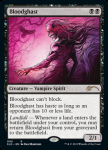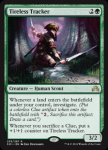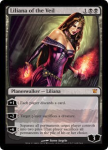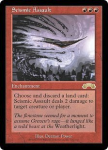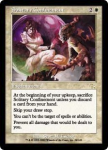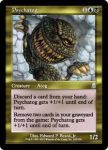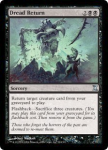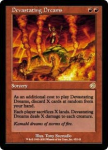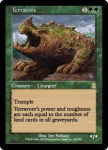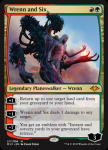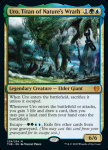Oversoul
The Tentacled One
Along with Death Loam, there was also Loam Pox. It didn't have the connection to the Extended format archetype and was a Legacy original. I was more cognizant of Death Loam because my friend played it, but the Pox version was less mana-intensive and ultimately lasted much longer. Loam Pox was slower than the traditional monoblack Pox. It was even more of a grind. But Life from the Loam contributed impressive resilience. Generally, this archetype dropped cycling land engine typical of Loam decks, or at least reduced its prevalence. The Loam engine wasn't really the main gameplan, and, Retracing Worm Harvest and Raven's Crime were more typical maneuvers for this version of the Pox deck. By the time a Loam Pox player was dredging up Life from the Loam, it had already depleted the opponent's hand with Hymn to Tourach, Smallpox, Raven's Crime, Thoughtseize, and Pox. The idea was to put both players in topdeck mode with no hands, no creatures, and few lands. But while the opponent was in a precarious position, the Loam Pox player could simply dredge up Life from the Loam, cast it, and always make land drops, discarding surplus lands to cast Retrace spells. Bloodghast or Nether Spirit would come back from the graveyard, potentially joined by Mishra's Factory, and the vulnerable opponent would succumb within a few turns once that board state was reached.
Unlike the aforementioned Death Loam archetype, this one didn't really run mana acceleration and wasn't really a black/green deck, but more of a black deck with a green splash. The only cards that used green mana were Life from the Loam and Pernicious Deed. Everything else was black (Worm Harvest was a staple here, but could be cast with only black mana). So this played very differently from most Loam decks. Occasionally the green splash would be used for another card, such as Crop Rotation or Maelstrom Pulse, but mostly it was just Life from the Loam and Pernicious Deed in a sea of black spells.
Although it was a bit slower than the traditional Pox archetype, Pernicious Deed was such a valuable addition that a slight green splash had been somewhat popular even before Life from the Loam. And since LftL proved a much more reliable land recursion tool than Crucible of Worlds, the deck shifted focus toward that, with the Retrace spells augmenting the new Pox variant. In fact, Loam Pox started to become more of a Pox deck than the regular monoblack "Pox" deck, because it could more regularly afford to cast the deck's namesake card. By 2010 or so, most Pox decks were relying on Smallpox, not on the original Pox card itself.
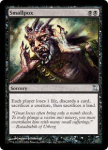
Pox, or "Big Pox" as it came to be called, was sometimes awkward because it wasn't always feasible early in the game to put the opponent on the wrong side of rounding up for it, whereas Smallpox was faster and easier to control, serving as Diabolic Edict, Sinkhole, and Mind Peel all rolled into one spell. Smallpox became the staple that defined Pox decks and set them apart from all other control decks in Legacy. While the original Pox played a roll, it was more of a haymaker and generally Pox decks scaled it back from a full playset to 1 or 2 copies. Loam Pox, which focused on recovering its own dead lands, could afford to focus on "Big Pox" more, and tended toward 3 copies. This made it better at grinding down opposing control decks, and the inclusion of Pernicious Deed made it more flexible. If things had gone differently Loam Pox might have stuck around as the premier Smallpox deck in the Legacy format. But that was not to be.
The advent of Liliana of the Veil revolutionized Pox decks, and monoblack Pox came back with a vengeance. The planeswalker could hit the board first turn with Dark Ritual, and if the opponent couldn't kill it quickly, the game would be taken over soon after that.
Unlike the aforementioned Death Loam archetype, this one didn't really run mana acceleration and wasn't really a black/green deck, but more of a black deck with a green splash. The only cards that used green mana were Life from the Loam and Pernicious Deed. Everything else was black (Worm Harvest was a staple here, but could be cast with only black mana). So this played very differently from most Loam decks. Occasionally the green splash would be used for another card, such as Crop Rotation or Maelstrom Pulse, but mostly it was just Life from the Loam and Pernicious Deed in a sea of black spells.
Although it was a bit slower than the traditional Pox archetype, Pernicious Deed was such a valuable addition that a slight green splash had been somewhat popular even before Life from the Loam. And since LftL proved a much more reliable land recursion tool than Crucible of Worlds, the deck shifted focus toward that, with the Retrace spells augmenting the new Pox variant. In fact, Loam Pox started to become more of a Pox deck than the regular monoblack "Pox" deck, because it could more regularly afford to cast the deck's namesake card. By 2010 or so, most Pox decks were relying on Smallpox, not on the original Pox card itself.

Pox, or "Big Pox" as it came to be called, was sometimes awkward because it wasn't always feasible early in the game to put the opponent on the wrong side of rounding up for it, whereas Smallpox was faster and easier to control, serving as Diabolic Edict, Sinkhole, and Mind Peel all rolled into one spell. Smallpox became the staple that defined Pox decks and set them apart from all other control decks in Legacy. While the original Pox played a roll, it was more of a haymaker and generally Pox decks scaled it back from a full playset to 1 or 2 copies. Loam Pox, which focused on recovering its own dead lands, could afford to focus on "Big Pox" more, and tended toward 3 copies. This made it better at grinding down opposing control decks, and the inclusion of Pernicious Deed made it more flexible. If things had gone differently Loam Pox might have stuck around as the premier Smallpox deck in the Legacy format. But that was not to be.
The advent of Liliana of the Veil revolutionized Pox decks, and monoblack Pox came back with a vengeance. The planeswalker could hit the board first turn with Dark Ritual, and if the opponent couldn't kill it quickly, the game would be taken over soon after that.

